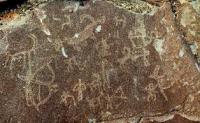Вы здесь
Petroglyphs of Vybistdara.

Tour to Petroglyphs in Pamir Tajikistan.
“An ancient burial site will always hold clues as to who the people were, and to who we are”
Anthony T. Hincks.
Tour of Vybistdara Petroglyphs.
Petroglyphs of Vybistdara in the Gorno-Badakhshan Autonomous Region, in the Shungon district, 30km east of Khorog City and 7 - 8km away from Debast (Vybist), on the left bank of the Vybist-Dara River near the summertime encampment (kosh) Tirel; altitude: 3,500m.
There is a total of 1,203 drawings registered on an area of 1.2 ha. Level of Study The Vybistdara petroglyphs were discovered in 1960 by a biologist, A.V. Gurskiy. In 1972, the site was surveyed by a petroglyph researcher group from the Pamir Archeological Party of the AS of Tajikistan (group leaders: Ranov V.A., Zhukov V.A., etc).
The boundaries of the main concentrations of petroglyphs were established and the groups described; the most interesting drawings were photographed and traced on paper. The petroglyphs were provisionally classified (Ranov 1976: 6-12; 2001: 146 - 147), but most have remained unpublished.
Description of the Site Petroglyphs are pecked on the patinated surfaces of large fragments of granite in large mound
The largest petroglyph concentration (including the most ancient) is near a site of summer pasture. In general, the repertoire of petroglyphs is not very varied, but it is notable for a large number of humans, signs and ornamental motifs.
The most common motif is a row of horse riders following one another. There are many scenes of hunting archers including horse riders. A scene of wild yak communal hunting was carved on a large surface. There are several examples of an armed man fighting an unarmed man and varying motifs of running men holding hands.
Numerous signs such as circles with a central point and an intersection, florets, and squares are interesting. The latest images include an open palm – a famous symbol of Pamirian Ismaili. Rare images include camels, dogs, and chariots.
According to style and repertoire, there are images of the Early Iron Age (few images of animals in a tradition of animalistic style) and of the Islamic medieval period including its end (horse riders, battle scenes, signs, open palms) (Ranov 1976: 6 - 12).
The drawings are dated from the 1st millennium BC to the XVIth - XIXth centuries, and medieval petroglyphs prevail.
Authority:
Bobomullo S. Bobomulloev.
Photos by
Surat Toymasov.







